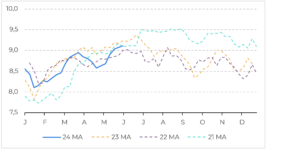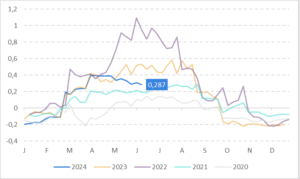Driving Season: Impact on the North American Fuel Market
Understand how the US driving season impacts fuel values and expectations for the 2024 season.
The driving season in the United States is a period of significantly increased gasoline consumption due to a rise in travel caused by higher temperatures and school vacations in the northern hemisphere. This cultural behavior leads to a notable surge in fuel usage, generating numerous market reactions.
The driving season begins on Memorial Day and ends on Labor Day. In 2024, this period started on May 27 and will end on September 2. Historically, local gasoline prices undergo changes during these months, influencing fuel prices in the country and around the world.
In this post, Victor Arduin, Energy and Macroeconomics analyst at Hedgepoint, covers the main topics on the subject. With him, we will understand how the driving season impacts the fuel market and what the data and expectations are for the rest of this year’s season. Enjoy the read!
The Influence of the Driving Season in North America
According to the International Energy Agency (IEA), the United States is the world’s largest consumer of oil. During the driving season, its daily consumption of petroleum products increases. This year, more than 75% of Americans plan to hit the road in the summer.
The Vacationer survey found that this number represents more than 212 million adults. Data from the Energy Information Administration (EIA) shows that the average daily gasoline consumption in the U.S. is below 9 million barrels per day (bpd) during the winter. However, during the “driving season” from June to August, consumption rises and occasionally exceeds 10 million bpd, according to the Energy and Macroeconomics analyst at Hedgepoint.
 “This is a hot period in the United States, so people travel more inland. This increases the demand for gasoline and usually also impacts fuel prices,” says Victor Arduin.
“This is a hot period in the United States, so people travel more inland. This increases the demand for gasoline and usually also impacts fuel prices,” says Victor Arduin.
Such significant numbers have a direct impact on both the American and global economies. Arduin reports that the driving season typically influences gasoline prices in other countries because the pricing in the world’s largest economy affects international futures contracts.
“The rise in gasoline prices in the U.S. significantly impacts gasoline prices in importing countries. However, this impact is complex and depends on various factors such as exchange rates, fiscal policies, market structure, and domestic demand,” says the Hedgepoint professional.
Read also:
– Futures contract: how does it work in the grain and oilseed market?
Expectations for the 2024 Driving Season
At the beginning of the year, estimates for the driving season were similar to previous years’ data. However, the summer of 2024 has shown different behavior than expected. The main indicators that quantify the American economy during this period are demand, gasoline prices, and the national fuel stock. Understand how these factors are behaving:
-
Gasoline Demand
Victor Arduin explains that the data tracked so far indicate a driving season not as significant as previously projected. The Hedgepoint analyst states that there was the usual increase in gasoline demand starting in May, but the numbers did not reach the expected estimate. See below:
Data on gasoline consumption in the United States

In the graph, it is possible to see that demand grew but was below the numbers observed in the past. Compared to the previous two years, the 2024 line showed that gasoline consumption this season is less significant than before.
The Energy and Macroeconomics analyst at Hedgepoint explains that some factors may have influenced this occurrence, such as high inflation and the increase in the use of electric cars.
According to the U.S. Energy Information Administration, the average gasoline consumption in the first week of June was 9.040 million barrels per day. Last year, this number reached almost 10 million in the same period. “In previous years, Americans consumed more gasoline. This may also have happened because they were post-pandemic years along with inflation,” Arduin adds.
-
Fuel Prices
Historically, fuel prices rise during the driving season. However, this is another factor that has acted differently in 2024. As Arduin states, higher prices were expected due to the previous demand estimate for this period.
Additionally, another indicator that led to the forecast of price increases was the conflict between Russia and Ukraine. In recent years, this event has impacted American and global fuel stocks.
However, prices did not follow the initial expectations for these summer months. In fact, they are lower than in previous years, as Arduin explains: “As in 2022 and 2023, the season showed a significant rise in gasoline prices, the same was expected for 2024. Generally, the United States changes the fuel formulation to pollute less during this period, which also ends up increasing the final prices.”
To demonstrate, the Hedgepoint professional presented a new graph with the most recent data of the season:
Market Expectation Regarding Gasoline Prices

In the image, it is possible to see that in the last two years, the U.S. gasoline futures market (RBOB) presented a more expressive backwardation (meaning the price difference between nearby and future contracts is larger, indicating more pressure on short-term stocks) but in 2024 it has lost strength.
According to CBS News, fuel prices in the second week of June are 14 cents lower than in the same period last year. Victor explains that some factors may have influenced this drop in gasoline prices, such as the economic performance and the demand increase that did not reach their estimates.
-
National Fuel Stock
Despite geopolitical conflicts in Russia and Ukraine, the fuel stock in America is higher for this time of year. Hedgepoint created a graph that highlights this growth compared to previous seasons:
Gasoline Stock Levels in America

The data shows that the stock line has been rising in the last month and is higher than in 2023, which helps to alleviate the pressure on gasoline prices currently. Additionally, the local government also announced the release of 1 million barrels of gasoline from a Northeast reserve. The goal was precisely to reduce final prices for this travel season, but this was not the only influencing factor.
According to CBS News, oil prices fell, and fuel demand also weakened. These are unusual circumstances for this period and have surprised the market. “With high stocks, low demand, and better oil prices, the pressure on American gasoline prices is milder,” concludes Victor.
Read Also:
- Hedge Operations: What are accumulator products?
Market Intelligence in Risk Management
At Hedgepoint, a market intelligence team works with fast and updated information on prices, stocks, and demand. As you saw in this text, these are the main factors that influence the fuel market and directly affect barrel prices.
With this type of work, the team can predict market movements and manage financial risks for companies that work with buying and selling oil. If you also want to have access to this data and reports, just visit and learn more about Hedgepoint HUB: a digital platform with updated materials produced by the market intelligence team.






